|
Ladies and gentlemen. We would like to start this blog post by announcing our intent to apply for 2 new Guinness World Record attempts. One for the earliest arrival at an airport and the other for the longest wait time for an hour and half flight with only a 45 minute delay! To explain, the hotel check out was midday but the free shuttle to the airport was at 11:30, so we arrived at the airport at 11:31 for our 17:30 flight to Vientiane, Laos (pronounced Lao, like cow!). It was a long hang on made worse by both the eerie amount of cancelled flights from the airport (mostly to China) and the fact our check in desk didn't open until 15:30! Phnom Penh airport is nice however, we would not recommend spending much time land side! We can however, recommend Vietnam airlines! They are very spacious, lovely staff and a free bottle of water! Although they did take the long way round from Ho Chi Minh City (Saigon) to Hanoi by going via Phnom Penh and Vientiane! We finally got to the hostel, Sailomyen Cafe & Hostel, at 20:45, and after a quick bite to eat in one of the only open restaurants, The Galleria Coffee & Bar (where we ate pasta with chopsticks), we headed to our very comfortable, non smoke smelling bed! After our free breakfast the next morning, we headed out to do some sightseeing and how amazed we were to see pavements absolutely everywhere! Not far from the hostel is Patuxay Monument, (Patuxay translates to Victory Gate) a concrete structure, based on the Arc de Triomphe. It stands within a state park and was built in the 1960's to commemorate those who had given their lives during WWII and the 1949 war for independence from France. The park is also beautiful and very peaceful considering we were city centre in SE Asia, not an experience we have come across very often! We walked on to Pha That Luang which is considered Laos' most sacred temple and it is believed to enshrine Buddha's breastbone (yeah, we find it a bit odd as well that Buddha has seemingly been cut up worse than a cadaver for a 1st year anatomy class and then spread across India and SE Asia!) The site has had a monument on it since the 3rd century BC although in different iterations over the centuries due to wars. The current version was built in 1566 and restored in the 1930's by the French after Siamese forces sacked it in the 19th century. The statue in front of the temple is of King Setthathirath, King of Lan Xang kingdom who founded the 1566 temple and is considered one of the greatest leaders in Laos history. After walking around this spiritual site, that also includes a Buddhist convention hall, we decided not to go inside the temple as there was a 10,000Kip (£0.91) foreigner fee which, has got a bit tiring as the entry for locals was 3,000Kip. Could you imagine the outrage at home if Wallace Monument had a £35 entry fee for foreigners but Scottish people only paid £10.50 (don't @ us, we checked it)! As we were walking back downtown, Katy's eye was caught by a white stupa, which turned out to be the Unknown Soldier Monument which was opened in January 2009. The base depicted scenes from battle but no entry barriers kept us on the pavement. The last bit of sightseeing for the day was That Dam Stupa, and yes, we only went for the name!! Feels like it should have a hashtag before it doesn't it!? It translates as 'Black Stupa' but we much prefer the untranslated version. The stupa was built in the 16th century and is believed to be home to a 7-headed water serpent (Naga) that tried to protect the city during an invasion by the Siamese. It is still widely regarded as the city's guardian spirit although the stupa takes on more of a Bagan feel to it today as the gold was taken by the Siamese during the 19th century and nature has started to reclaim it. The afternoon was spent relaxing in the room as the temperature rose. For dinner we headed to Khop Kai Deu, a Laos restaurant that served beautiful food and we both left absolutely stuffed! We started Tuesday's sightseeing to see the Chao Anouvong Statue, a king during the early 19th century who had been a great builder during his reign and had also united 2 of the 3 Lao kingdoms. We left the statue and river behind and walked to the City Pillar Shrine, opened in 2012 after artefacts from the original city pillar were discovered here dating back to the 4th and 5th century. Katy was wearing shorts so wasn't allowed in but Craig climbed the stairs and saw inside where some of the artefacts are now housed, surrounding the new shrine from behind glass cases. On we walked to Wat Si Muang, a Buddhist temple, that was very ornately decorated however we didn't go in because of Katy's shorts! The next stop, and a highly recommended stop on any visit to Vientiane, was to the Cooperative Orthotic & Prosthetic Enterprise (COPE) centre. It was opened in 1996 to deal with the growing cases of people surviving interactions with unexploded ordnance (UXO) in Laos due to the bombs that were dropped here during the secret war run by America from 1964-1973. The mission for the Americans was to disrupt the so called Ho Chi Minh supply chain from Hanoi to the south during the Vietnam war. This war resulted in Laos becoming the the most bombed country per capita in the world (a record that stands to this day), and caused the injury or death of over 50,000 Laotian people and, of those, nearly 30,000 (half of which are children) of them have occurred since the bombs stopped falling as the Americans used cluster bombs. Cluster bombs are dropped as large bombs from planes but the casings open on descent to reveal roughly 200 smaller bombs, (about the size of an orange) known as 'bombies', that cause widespread devastation as they spread out and detonate on impact. During the 9 year period, 270 million sub-munitions from cluster bombs (around 2 million tonnes) were dropped on Laos, and an estimated 10-30% never exploded resulting in 25% of Laos villages (and 35% of the country) to be polluted with UXOs. The problem with UXOs is they won't detonate when they are stood on, like a landmine, if they are buried under top soil, but can explode when struck by a farmer turning their rice field or, when they are warmed from a fire that has been lit to cook a family dinner or, when children find a metal ball they can throw to each other and one accidentally drops it. The real sadness is the scrap metal trade is very valuable to the majority of Laotians who live in rural locations as most live in poverty and work the land for a living. They use what ever metal they find to either sell as scrap or to craft items for personal use, sadly this carries the increased risk of encountering UXOs. One man lost his leg to an UXO and, after recovering, made himself a leg from bamboo, to bind the rudimentary prosthetic leg, he used metal found from a UXO, the same type of bombie that had taken his leg. The COPE centre has been established to help those affected, by providing a training base for the care givers and a rehabilitation centre to help those in need of prosthetics and orthotics. It also promotes the work of the 3,000 international people who are currently clearing UXO's in Laos, and the expansion of COPE's work as they now have the funding to travel to rural communities and provide those in need with the limbs, support and healthcare they require. This is hugely beneficial to these poor communities and the families of those affected as healthcare costs can be crippling. The COPE centre does a fantastic job of providing all of their services for free to those who need it but they do rely on funding from visitors and other nations to support this. In 2016, Barack Obama was the first American president to visit Laos in 2016 and promised to double the funding, via USAID, to $90million over 3 years to help atone for the secret war that has so ravaged this country. To put this in context however, America spent $13.3million per day, for 9 years, bombing Laos. Outside the museum there is a statue of a mother and child made from the scrap metal from bombs discovered in Laos, somewhat normalising the frequency of bombs found here. Once we had explored the museum and exhibits we went for a coffee to Cafe Nomad, a lovely spot that also had a dual purpose, it let us print our bus tickets for our travels around Laos! The afternoon was spent relaxing before heading back out for dinner at 17:00 to Bor Pen Nyang Bar & Restaurant, 4 stories up where we watched the sun set over Thailand and enjoyed a peaceful meal. After dinner we fancied something sweet as we hadn't eaten any lunch so went to Sweet Moo, an ice cream shop, where we shared a peanut butter ice cream sundae. Once we got back to the room we packed up and got ready to head north, to Vang Vieng.
0 Comments
Leave a Reply. |
ArchivesCategories
All
|



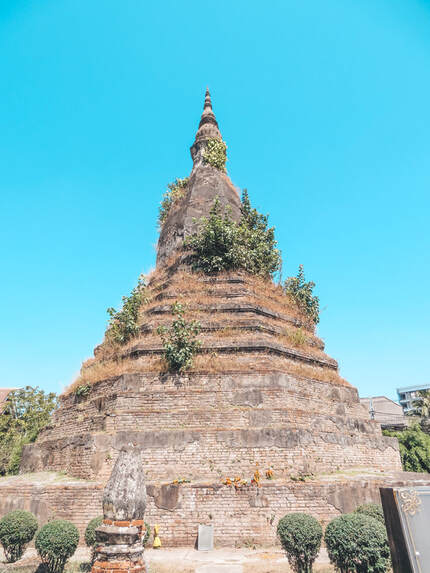

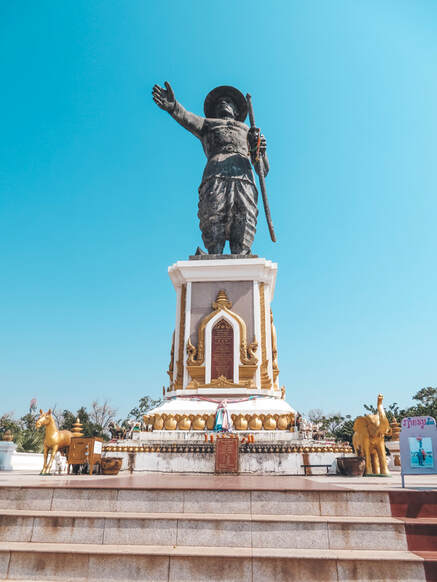
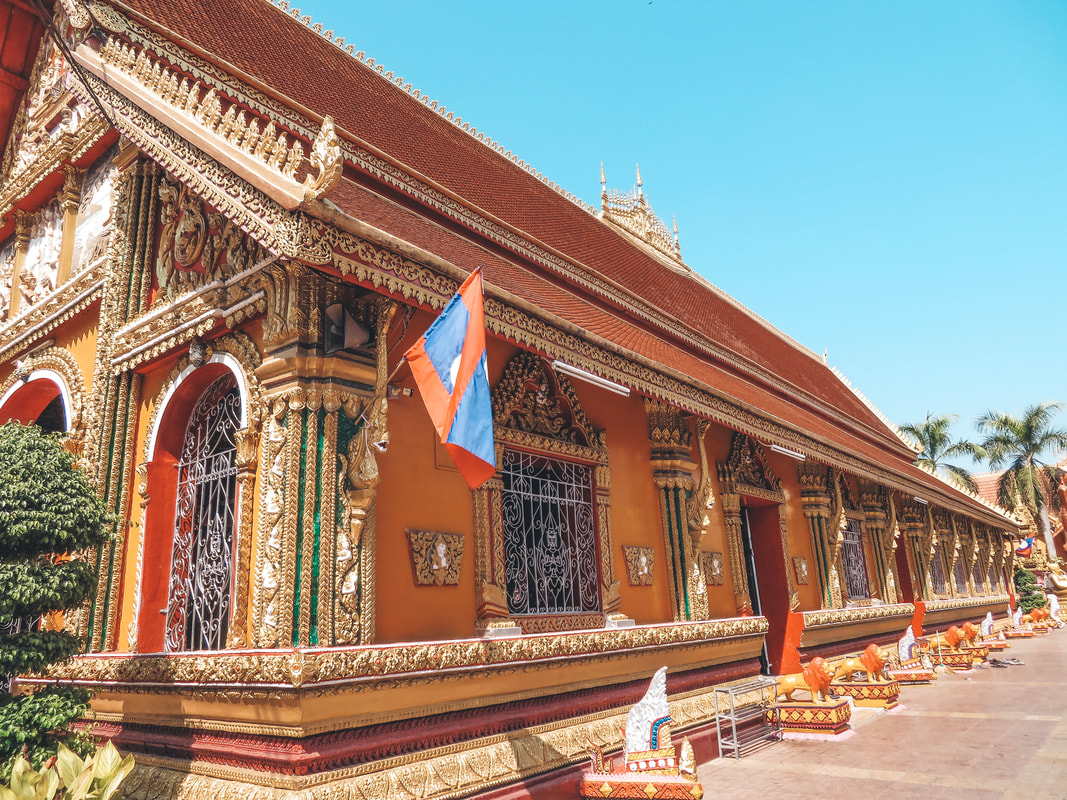
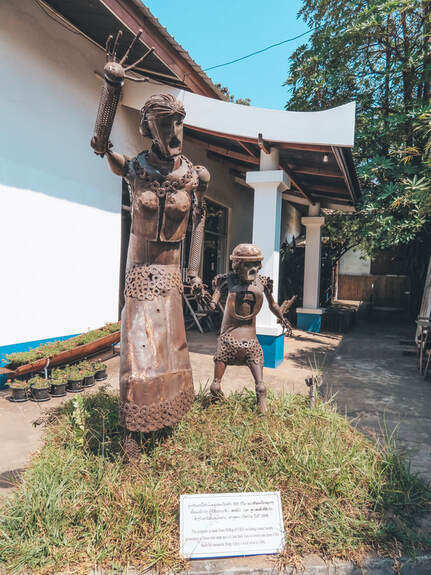

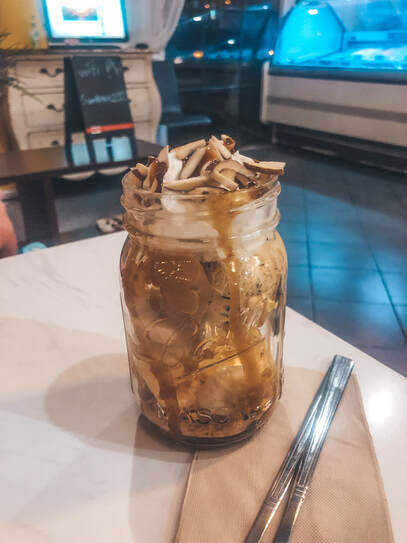
 RSS Feed
RSS Feed